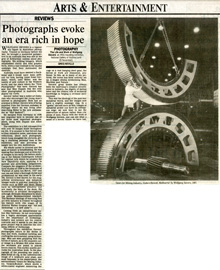
Photographs evoke
an era rich in hope
The Age 11.10.1991
Wolfgang Sievers is a legendary figure in Australian photography. Trained in Germany before the war, he brought a modernist perspective to an Australia that was still in the grip of Edwardian notions about photography. His striking imagery, which emphasised clarity and bold graphic form, were a real contrast to the mushy nostalgia that then dominated the medium.
Australia must have seemed a backwater and it would have been difficult for him, having come from Germany, which, until Hitler, was the centre of new culture in the Western world, and the place where the “New Photography” was born. Slevers has said that Max Dupain was the only other photographer in Australia who shared his views.
Slevers’ father was a noted art historian who encouraged the young man’s interest in photography. Both had an aversion to Hitler: Sievers tells of being expelled from the German embassy in Portugal where he was living after describing Hitler to the new ambassador as “that bastard”!
He escaped from Germany in 1938 and migrated here to become one of our three most important photographers, along with Dupain and Athol Shmith.
The exhibition is a full retrospective with over 80 images made throughout his life. It is unusual in that Sievers has written extensive notes, anecdotes and reflections, about each photograph, which hang alongside the pictures, giving a charming personal tone to the exhibition, and also providing an insight into his own motivations.
His whole career is covered and the span of history is breathtaking. He was making fine landscape and architectural images in his early 20s before studying at the famous Contempora School for Applied Arts where he adopted the New Objectivity style, applying it to^ portrait and advertising assignments. Compare the elegance of the architectural studies of 1936 to the bluntness of Portrait of Astra von Borch, 1937′ and one can see what a thorough stylist and professional he was even in his early 20s. Sievers is best known for the magnificent architectural and industrial images made in post-war Australia for clients such as BHP and Shell. These have an unforgettable grandeur and are really the stars of the show. His modernity is evident throughout, although obviously sharpened by studying under Bauhaus-trained teachers. The Bauhaus ideology of marrying fine art with industry is evident throughout his mature work (the slogan of its director Walter Groptus was “Art and technology — a new unity”),
Coming from an industrialised nation like Germany, he not surprisingly has a highly developed appreciation for the Importance of technology. Industry and science are his central concerns and it seems to me that his great project was to describe the civilising effects of technology.
Throughout the exhibition Sievers’ photographs return to the theme of man and work, mankind building and Grafting the environment, using technology. Men are seen grappling with the forces of nature, as in the exquisite color image in a Broken Hill mine where the workmen are posed in almost heroic stances. This mythic quality pervades the Australian work. In the photograph of the pounding sea under a Bass Strait oil rig, in the cathedral-like image of a sulphuric acid plant, and most famously in his masterpiece, the extraordinary ‘Gears for Mining Industry, Vickers-Ruwolt’, which shows a white-coated engineer measuring the cogs on a vast hanging steel gear, the forces at work are elemental, profound. In this, as in many of his pictures, the scene has been entirely set up, a staged drama symbolising Man, Machine and Nature.
Sievers’ great theme has always been the individual’s creative involvement in industry, the dignity of skilled labor and the central role of technical knowledge in forging a civilised environment.
This was the ideology of the post-war Industrial world, and the images now have a slightly nostalgic ring. In a “green” decade such as this, images ol industrial power can have an ambiguous edge; we now tend to see the destruction of nature rather than creations of men. Faced with the work ol Wolfgang Sievers, one can see what a sense of a heroic future we have lost.